Introduction
These days, the need for electrical power is growing quickly.
That could be fulfilled by the power generating substations.
You will find various types of power generating substations such as:
- hydro-electric
- atomic and;
- thermal
Based on the accessibility of various sources, substations are building at various locations.
However, such locations might not be nearer to load centers.
The power usage could be achieved by the load center.
Therefore, it is vital to transmitting power from the substation to load center locations.
Long and high transmission networks are necessary for this function.
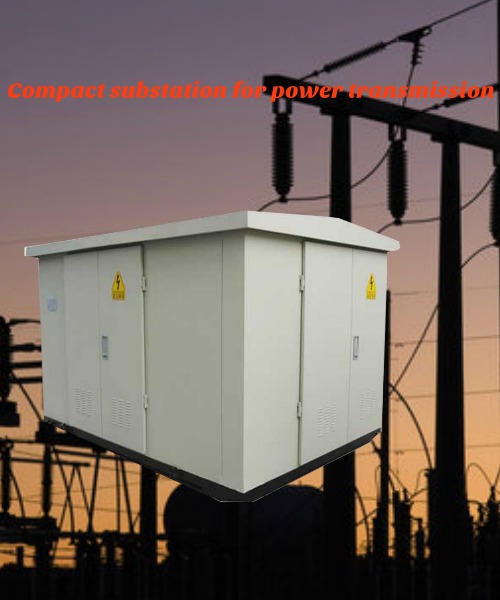
Power is produced comparatively in the level of low voltage level.
Nonetheless, it’s costly to supply power at a high-voltage level.
For keeping low and high voltage levels, several transformations and switching stations should be made among them:
- the customer ends and;
- generating place
Those two stations are called electrical substations.
Take note that compact substation is divided into three compartments.
- Transformer distribution compartment
- Low voltage distribution compartment
- High voltage distribution compartment
Each of them has different parts:
Bear in mind that the compact substation designs are dependent on the need.
For Transformer Distribution Compartment, there is:
- low voltage inlet switchgear
- low voltage outlet switchgear
- low voltage compensation switchgear
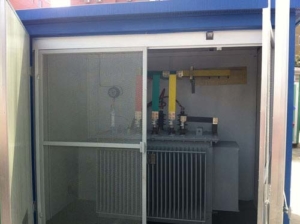
Transformer distribution compartment
When we talk about low voltage distribution compartment, it’s composed of the following:
- load isolating switch
- current transformer
- switched capacitor contractor
- capacitor
- lighting arrester
Ultimately, a high voltage distribution compartment is composed of:
- lightning arrester
- high voltage grounding switch
- high voltage fuse
- high voltage switch
- electromagnetic lock
- live display
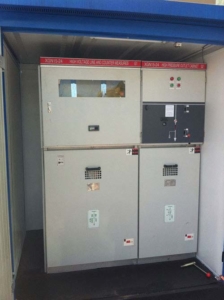
High voltage compartment
Overall, a compact substation is composed of the following components:
- isolators
- capacitors bank
- bus bars
- circuit breakers
- relays
- electrical power transformers
- insulators
- conductors
- lighting arresters
In this post, we will discuss the different components of compact substation and their functions.
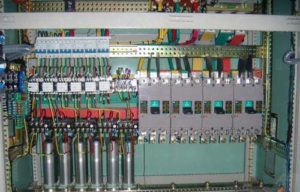
Components in compartment
There’s a need for collector substation in cases of big power generating system.
For instance, hydropower and multiple thermal plants are linked together.
This is for transfer of power to a single transmission unit from different co-located turbines.
Below are some of the major components of substations as well as their working.
Every component functions are discussed in detail along with machinery.
Potential Transformers
This component of the compact substation is used for transfiguring high voltages to low voltages.
They are used for protection of the relay system and for lowering metering of voltage measurements.
Switchyard
The transformers, circuit breakers, switches, and switchyards are for the disconnection and connection of:
- circuit breakers and;
- transformers
Those also have lighting arrestors to safeguard the substation from strokes of natural lighting.
Wave Trapper
A wave trapper is considered one of the components of a compact substation.
This is situated on the incoming lines for stopping high-frequency waves.
Such high-frequency waves that come from close substations and other localities are obstructing the voltages and current.
Therefore, its trapping is of utmost importance.
You see,
The wave is tripping high-frequency waves and is diverting the waves into telecom panel.
Batteries
Some of the vital parts of a compact substation like:
- automated control circuity
- relay system
- emergency lighting
are run through batteries.
The size of the battery bank depends on the voltage needed for the operation of the DC circuit.
The storage batteries are composed of two types:
- lead acid batteries and;
- acid alkaline batteries
The common type and most utilized batteries are the lead-acid batteries.
They offer high voltages and are much affordable in cost.
Capacitor Banks
On the other hand;
Capacitor banks are determined as a collection of several identical capacitors.
They are linked in either series or parallel inside an enclosure.
They are used for the correction of power factor and protection circuitry of the substation.
These serve as a source of reactive power.
In short, they lower phase difference amid voltage and current.
Those raises the capacity of ripple current of supply and prevent unwanted selves within the substation system.
The utilization of capacitor banks is a very effective way for:
- correction of issues connected to power lag and;
- power factor maintenance
Relays
In case you didn’t know yet, relays are a component of compact substation for the protection of the system from abnormal cases.
An example of these faults.
Normally, relays are sensing gadgets that are committed to tracking faults.
It identifies its location and sends interruption message f tripped command to the particular point of the circuit.
What’s more:
A circuit breaker falls apart its contact once it gets the command from the relays.
It safeguards the equipment from other damages like:
- the risk to human life
- fire
- elimination of fault from a specific section of the substation
Circuit Breakers
A circuit breaker is a kind of switch used for opening or closing circuits when a fault happens in the system.
The circuit breaker has two mobile contacts that are off condition in normal cases.
When any fault happens within the system, a relay transmit the tripped command to the circuit breaker.
It moves the contacts apart.
Thus, it prevents any damage to the circuity.
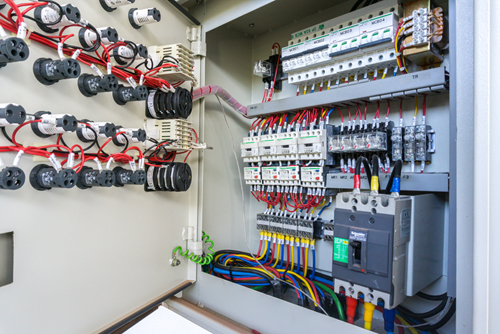
Lightning Arresters or Surge Arrestors
This compact substation component could be determined as the first component of a substation.
These protect the equipment form high voltages.
They limit the duration and the amplitude of the flow of the current.
These are intended for diversion of current to earth when any current surge shows.
It safeguards the conductor and insulation from any damages.
You will also find other types that are different according to their duties.
These component discharge the overvoltage surges to earth.
It safeguards the equipment insulation from lightning surges and switching surges.
You see,
Surge arresters are normally connected between ground and phase conductor.
A substation surge is situated at the beginning of the substation as observed from incoming transmission lines.
They are also presented close to the transformer terminals phase to ground.
Bus Bars
A bus bar is among the most vital elements of the substation.
It’s a conductor that carries current to a point having different connections with it.
It’s a type of electrical junction having incoming and outgoing current paths.
When a fault happens in the bus bar, the overall components linked to that particular section must be tripped for providing comprehensive isolation in a minor.
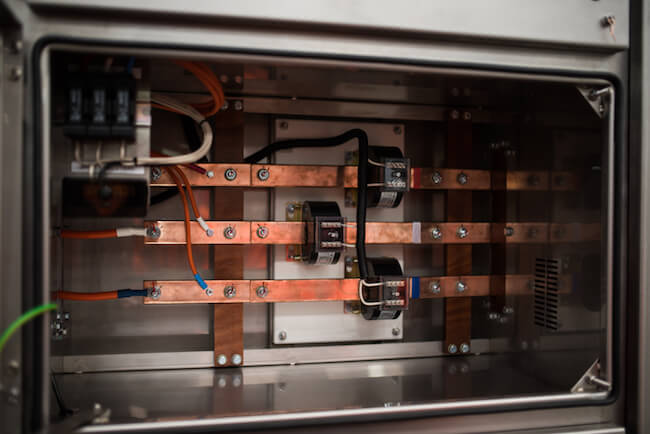
Some of the types of bus bar are:
- single bus
- double bus
- ring bus
Also referred to as buses, these can be seen as the entire power system.
Busbars are utilized to bring big current and to distribute current to various circuits in equipment or switchgear.
Plug-in devices with fusible switches or circuit breakers might be wired and installed without de-energizing the bus bars.
These are composed of uncovered copper conductors supported on insulators.
This kind of construction was sufficient for current ratings of 225 to 600A.
Isolators or Disconnecting Switches
The isolator in the substation is a mechanical switch that is deployed for isolation of circuits when there’s an interruption of current.
Those are known with the term of disconnected switches operation below no-load condition.
They aren’t stimulated with arc-quenching devices as well.
Such switches don’t have any particular breaking value, neither those have current making value.
Ultimately, they are mechanically operated switches too.
These are provided for isolation from the live parts for the purpose of maintenance.
You see, these are situated at either side of the circuit breaker.
They are operated under no load.
Isolators don’t have any rating for current making or current breaking.
Isolators are interlocked along with any circuit breakers.
Insulators
This material does allow the flow of electrons within it.
In fact, they resist electric property.
You will find different kinds of insulators.
Some of these are:
- stray type
- suspension type
- strain type
- shackle
Insulators are utilized in compact substations for preventing short circuit and contact with humans.
Conductors
Did you know?
Conductors are the materials that enable the flow of electrons through it.
The best material for conductors is aluminum and copper.
The conductors are used for transmission of energy from place to place over compact substation.
Current Transformers
This is a device used for the conversion of high-value currents into lower values.
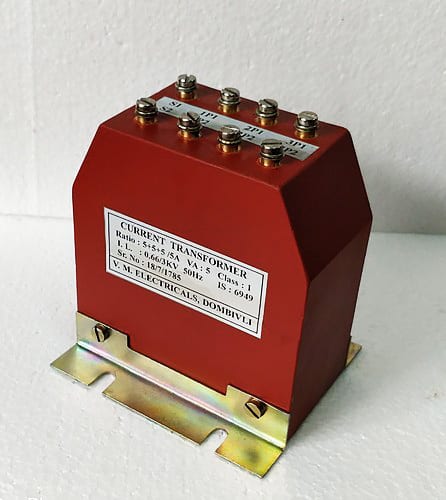
It is used in a similar way to that of:
- meters
- control apparatus and;
- AC instruments
These have low current ratings and are utilized for:
- maintenance and;
- installation of current relays
for protection of substations
Carrier Current Apparatus
This is fixed in the compact substation for:
- communication
- relaying
- supervisory control
- telemeter
This kind of system is placed properly in a carrier room by linking to the high-voltage power circuit
Voltage Transformer
A voltage transformer could be determined, as it’s an instrument transformer utilized for altering the voltage from a superior value to the minor value.
Conclusion
The compact substation design is a complicated method with a lot of engineering planning.
Are you now considering a substation designing?
This post presented an insight into the basics of compact substation and their major components of power systems.
The function of several components was discussed.
We hope we presented you enough information about the different components of a compact substation and their corresponding functions.
